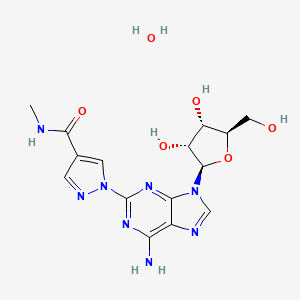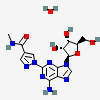Lexiscan
- Regadenoson hydrate
- Lexiscan
- 875148-45-1
- Regadenoson monohydrate
- UNII-2XLN4Y044H
- Create:2009-08-20
- Modify:2025-01-18

- CVT 3146
- CVT-3146
- CVT3146
- Lexiscan
- regadenoson
- Regadenoson hydrate
- Lexiscan
- 875148-45-1
- Regadenoson monohydrate
- UNII-2XLN4Y044H
- Rapiscan
- Regadenoson [USAN:INN:BAN]
- 2XLN4Y044H
- CVT-3146
- CVT3146
- Regadenoson (USAN)
- Adenosine, 2-(4-((methylamino)carbonyl)-1H-pyrazol-1-yl)-, monohydrate
- REGADENOSON [USAN]
- Regadenoson hydrate (JAN)
- 1-[6-amino-9-[(2R,3R,4S,5R)-3,4-dihydroxy-5-(hydroxymethyl)oxolan-2-yl]purin-2-yl]-N-methylpyrazole-4-carboxamide;hydrate
- REGADENOSON HYDRATE [JAN]
- 1-(6-Amino-9-beta-D-ribofuranosyl-9H-purin-2-yl)-N-methyl-1H-pyrazole-4-carboxamide, monohydrate
- Lexiscan (TN)
- REGADENOSON [VANDF]
- REGADENOSON [WHO-DD]
- REGADENOSON [EMA EPAR]
- CHEMBL3989695
- SCHEMBL15862934
- DTXSID70236374
- REGADENOSON [ORANGE BOOK]
- REGADENOSON MONOHYDRATE [MI]
- AKOS040747364
- REGADENOSON MONOHYDRATE [MART.]
- D05711
- 1-(6-AMINO-9-.BETA.-D-RIBOFURANOSYL-9H-PURIN-2-YL)-N-METHYL-1H-PYRAZOLE-4-CARBOXAMIDE, MONOHYDRATE



H300 (50%): Fatal if swallowed [Danger Acute toxicity, oral]
H302 (50%): Harmful if swallowed [Warning Acute toxicity, oral]
H310 (50%): Fatal in contact with skin [Danger Acute toxicity, dermal]
H312 (50%): Harmful in contact with skin [Warning Acute toxicity, dermal]
H315 (50%): Causes skin irritation [Warning Skin corrosion/irritation]
H319 (50%): Causes serious eye irritation [Warning Serious eye damage/eye irritation]
H330 (50%): Fatal if inhaled [Danger Acute toxicity, inhalation]
H332 (50%): Harmful if inhaled [Warning Acute toxicity, inhalation]
H335 (25%): May cause respiratory irritation [Warning Specific target organ toxicity, single exposure; Respiratory tract irritation]
H370 (25%): Causes damage to organs [Danger Specific target organ toxicity, single exposure]
P260, P261, P262, P264, P264+P265, P270, P271, P280, P284, P301+P316, P301+P317, P302+P352, P304+P340, P305+P351+P338, P308+P316, P316, P317, P319, P320, P321, P330, P332+P317, P337+P317, P361+P364, P362+P364, P403+P233, P405, and P501
(The corresponding statement to each P-code can be found at the GHS Classification page.)
Aggregated GHS information provided per 4 reports by companies from 3 notifications to the ECHA C&L Inventory. Each notification may be associated with multiple companies.
Information may vary between notifications depending on impurities, additives, and other factors. The percentage value in parenthesis indicates the notified classification ratio from companies that provide hazard codes. Only hazard codes with percentage values above 10% are shown.
Acute Tox. 2 (50%)
Acute Tox. 4 (50%)
Acute Tox. 1 (50%)
Acute Tox. 4 (50%)
Skin Irrit. 2 (50%)
Eye Irrit. 2 (50%)
Acute Tox. 2 (50%)
Acute Tox. 4 (50%)
STOT SE 3 (25%)
STOT SE 1 (25%)
◉ Summary of Use during Lactation
No information is available on the use of regadenoson during breastfeeding. To avoid exposure of the infant to regadenoson, nursing mothers should avoid breastfeeding for 10 hours after drug administration.
◉ Effects in Breastfed Infants
Relevant published information was not found as of the revision date.
◉ Effects on Lactation and Breastmilk
Relevant published information was not found as of the revision date.
- ChEMBLLICENSEAccess to the web interface of ChEMBL is made under the EBI's Terms of Use (http://www.ebi.ac.uk/Information/termsofuse.html). The ChEMBL data is made available on a Creative Commons Attribution-Share Alike 3.0 Unported License (http://creativecommons.org/licenses/by-sa/3.0/).http://www.ebi.ac.uk/Information/termsofuse.html
- ChemIDplusRegadenoson [USAN:INN:BAN]https://pubchem.ncbi.nlm.nih.gov/substance/?source=chemidplus&sourceid=0875148451ChemIDplus Chemical Information Classificationhttps://pubchem.ncbi.nlm.nih.gov/source/ChemIDplus
- EPA DSSToxRegadenoson hydratehttps://comptox.epa.gov/dashboard/DTXSID70236374CompTox Chemicals Dashboard Chemical Listshttps://comptox.epa.gov/dashboard/chemical-lists/
- European Chemicals Agency (ECHA)LICENSEUse of the information, documents and data from the ECHA website is subject to the terms and conditions of this Legal Notice, and subject to other binding limitations provided for under applicable law, the information, documents and data made available on the ECHA website may be reproduced, distributed and/or used, totally or in part, for non-commercial purposes provided that ECHA is acknowledged as the source: "Source: European Chemicals Agency, http://echa.europa.eu/". Such acknowledgement must be included in each copy of the material. ECHA permits and encourages organisations and individuals to create links to the ECHA website under the following cumulative conditions: Links can only be made to webpages that provide a link to the Legal Notice page.https://echa.europa.eu/web/guest/legal-notice1-(6-Amino-9-beta-D-ribofuranosyl-9H-purin-2-yl)-N-methyl-1H-pyrazole-4-carboxamide, monohydratehttps://echa.europa.eu/substance-information/-/substanceinfo/100.224.5141-(6-Amino-9-beta-D-ribofuranosyl-9H-purin-2-yl)-N-methyl-1H-pyrazole-4-carboxamide, monohydrate (EC: 695-796-5)https://echa.europa.eu/information-on-chemicals/cl-inventory-database/-/discli/details/230637
- FDA Global Substance Registration System (GSRS)LICENSEUnless otherwise noted, the contents of the FDA website (www.fda.gov), both text and graphics, are not copyrighted. They are in the public domain and may be republished, reprinted and otherwise used freely by anyone without the need to obtain permission from FDA. Credit to the U.S. Food and Drug Administration as the source is appreciated but not required.https://www.fda.gov/about-fda/about-website/website-policies#linking
- ClinicalTrials.govLICENSEThe ClinicalTrials.gov data carry an international copyright outside the United States and its Territories or Possessions. Some ClinicalTrials.gov data may be subject to the copyright of third parties; you should consult these entities for any additional terms of use.https://clinicaltrials.gov/ct2/about-site/terms-conditions#Use
- Drugs and Lactation Database (LactMed)
- Drugs@FDALICENSEUnless otherwise noted, the contents of the FDA website (www.fda.gov), both text and graphics, are not copyrighted. They are in the public domain and may be republished, reprinted and otherwise used freely by anyone without the need to obtain permission from FDA. Credit to the U.S. Food and Drug Administration as the source is appreciated but not required.https://www.fda.gov/about-fda/about-website/website-policies#linking
- European Medicines Agency (EMA)LICENSEInformation on the European Medicines Agency's (EMA) website is subject to a disclaimer and copyright and limited reproduction notices.https://www.ema.europa.eu/en/about-us/legal-noticeRapiscan (EMEA/H/C/001176)https://www.ema.europa.eu/en/medicines/human/EPAR/rapiscan
- EU Clinical Trials Register
- Open TargetsLICENSEDatasets generated by the Open Targets Platform are freely available for download.https://platform-docs.opentargets.org/licence
- FDA Pharm ClassesLICENSEUnless otherwise noted, the contents of the FDA website (www.fda.gov), both text and graphics, are not copyrighted. They are in the public domain and may be republished, reprinted and otherwise used freely by anyone without the need to obtain permission from FDA. Credit to the U.S. Food and Drug Administration as the source is appreciated but not required.https://www.fda.gov/about-fda/about-website/website-policies#linkingFDA Pharmacological Classificationhttps://www.fda.gov/ForIndustry/DataStandards/StructuredProductLabeling/ucm162549.htm
- NCI Thesaurus (NCIt)LICENSEUnless otherwise indicated, all text within NCI products is free of copyright and may be reused without our permission. Credit the National Cancer Institute as the source.https://www.cancer.gov/policies/copyright-reuseNCI Thesaurushttps://ncit.nci.nih.gov
- KEGGLICENSEAcademic users may freely use the KEGG website. Non-academic use of KEGG generally requires a commercial licensehttps://www.kegg.jp/kegg/legal.htmlAnatomical Therapeutic Chemical (ATC) classificationhttp://www.genome.jp/kegg-bin/get_htext?br08303.kegTarget-based classification of drugshttp://www.genome.jp/kegg-bin/get_htext?br08310.keg
- WikidataRegadenoson hydratehttps://www.wikidata.org/wiki/Q83118320
- PubChem
- Medical Subject Headings (MeSH)LICENSEWorks produced by the U.S. government are not subject to copyright protection in the United States. Any such works found on National Library of Medicine (NLM) Web sites may be freely used or reproduced without permission in the U.S.https://www.nlm.nih.gov/copyright.htmlregadenosonhttps://www.ncbi.nlm.nih.gov/mesh/67430916Adenosine A2 Receptor Agonistshttps://www.ncbi.nlm.nih.gov/mesh/68058908
- GHS Classification (UNECE)GHS Classification Treehttp://www.unece.org/trans/danger/publi/ghs/ghs_welcome_e.html
- MolGenieMolGenie Organic Chemistry Ontologyhttps://github.com/MolGenie/ontology/


 CID 219024 (Regadenoson)
CID 219024 (Regadenoson) CID 962 (Water)
CID 962 (Water)